Strong and Flexible Roadbed for
Elevated Model Railroad Track
Made from 5mm Plywood and Foam
Bonded with Polyurethane Adhesive
When creating roadbed for your model railroad track it’s hard to beat plywood topped by foam insulation for track that runs at table level. The plywood creates a solid subroadbed that also strengthens the benchwork; the foam creates a sound-deadening layer that is also easily shaped for scenic purposes.
For our O Gauge Model Railroad Layout Project we chose to use 5/8” plywood for the subroadbed on our table level track. It’s significantly stiffer than 1/2” plywood, but still significantly less expensive than 3/4” plywood. The 5/8″ plywood adds so much strength and rigidity that the benchwork on our O Gauge Model Railroad Layout Project is so sturdy a 200-lb man can stand on it. We topped this subroadbed with 1″ foam for the mainline and 3/4″ foam for the branch line.
But, in the real world of prototype railroading, not all track is level. Trains have to climb mountains and span gorges to reach their destinations. Our O Gauge Model Railroad Layout Project is no different. Our trains must climb a steep grade to traverse a large desert mesa before descending and passing beneath the upgrade track to reach vital industries and passengers located in the valley below.
Model railroad track that is elevated from the benchwork introduces several new engineering problems we have to deal with. If it were elevated evenly so it ran level, it would be easy to create risers on which to mount the 5/8” plywood and foam roadbed. But our elevated track is only level for about 18”. The rest of the track is on a grade – that is, it is either climbing from, or descending to, table level. In these circumstances, the incredible stiffness of our 5/8” plywood and foam roadbed works against us. When the track climbs a grade while on a curve, the roadbed resists the twist required to remain level across the width of the track and won’t lie flat against the risers.
Another problem is that the descending track passes beneath the climbing track. With plywood and foam, that’s 1 1/8” of roadbed thickness the descending trains have to clear when they pass beneath the upgrade track. As you will see when calculating the grade needed for one train to pass beneath another, 5/8” of plywood requires more than 12” of additional travel for a track climbing at 5% grade to provide adequate clearance. While 12” of additional track length may not seem like a lot, on a layout the size of our O Gauge Model Railroad Layout Project, it requires more space than we have.
One way around these problems would be to separate the plywood and foam, leaving the plywood at table level and putting the risers between it and the foam roadbed. But, without the support of the plywood, the foam will sag if not supported by risers every three to four inches. As you can see on our Calculating Model Railroad Grades page, that’s a lot of additional calculating and cutting of risers.
Luckily, we came up with a solution to both our problems: a foam and thin plywood sandwich bonded with a polyurethane glue that makes a remarkably strong yet flexible model railroad roadbed.
The 5mm (less than 1/4” thick) plywood we used for this sandwich is remarkably strong and flexible, but it’s the polyurethane glue that is the key to this solution. Most other adhesives would either chemically attack the foam, or not hold a bond when subjected to the twisting forces required to keep curved, graded track level from side to side.
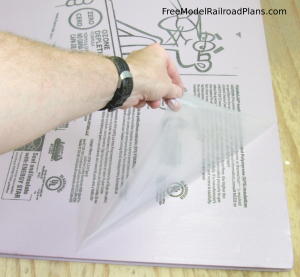


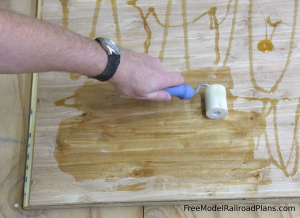

But polyurethane adhesives also have some idiosyncrasies that must be taken into account to be used successfully. Polyurethane adhesives start out as a thick, gooey liquid. Activated by water, it turns into a foam similar to the expanding foam insulation available in aerosol cans. These adhesives can expand three to four times their original volume, so a strong bond requires clamping to keep the two parts being joined in contact with each other. Since it’s virtually impossible to clamp a 4′ x 8′ sheet of plywood to a foam sheet of the same size, we resorted to using our old friend the force of gravity to help us.
First, however, as shown in Figure 1, we peeled off the thin plastic sheet on both sides of the foam. If you don’t do this, you may find it will separate from the foam later, destroying your sandwich.
Next, since the 5mm plywood is so flexible, you have to have a very flat base for the gluing operation. If there are any depressions on the floor, the strength of the expanding foam can force the plywood into it and away from the foam. We used a sheet of our 5/8” plywood to ensure we had a flat, even base beneath the 5 mm plywood. Lay the 5 mm plywood on top of this. This type of plywood is used as an underlayment beneath flooring, so it usually has a rough side and a smooth side. Lay it rough side up on the 5/8” plywood as shown in Figure 2.
Spread a bead of polyurethane glue evenly across the surface of the 5mm plywood, as shown in Figure 3. Then, using a hard wallpaper roller, spread the glue out on the sheet of 5 mm plywood as shown in Figure 4. Add more glue where needed and roll it out until the 5mm plywood is entirely covered with a very thin coat of glue.
Use a spray bottle of water to wet the glue evenly, as shown in Figure 5. It doesn’t take a lot of water, so set the bottle to a fine spray.
Lay the foam printed-side down onto the wetted, glue-covered 5mm plywood sheet, as shown in Figure 6.
Lay another piece of 5/8” plywood on top of the foam sheet to protect it, as shown in Figure 7. Immediately begin adding weight evenly on top of the 5/8” plywood sheet to keep the foam and 5mm plywood sheet in tight contact.
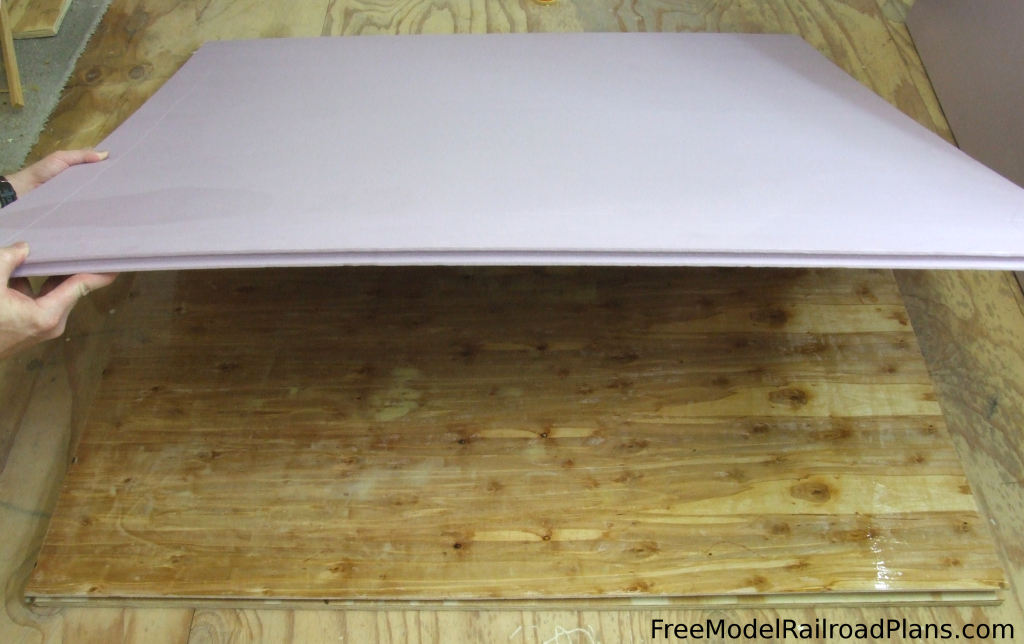

As shown in Figure 8, we used some bags of sand we had laying about for a landscaping project, but you can use anything- tools, lumber, cinder blocks, etc. Just make sure you get about 100 lbs. of weight evenly distributed onto every 2′ square section of the sandwich quickly, as the glue will begin foaming up within minutes of being wetted.
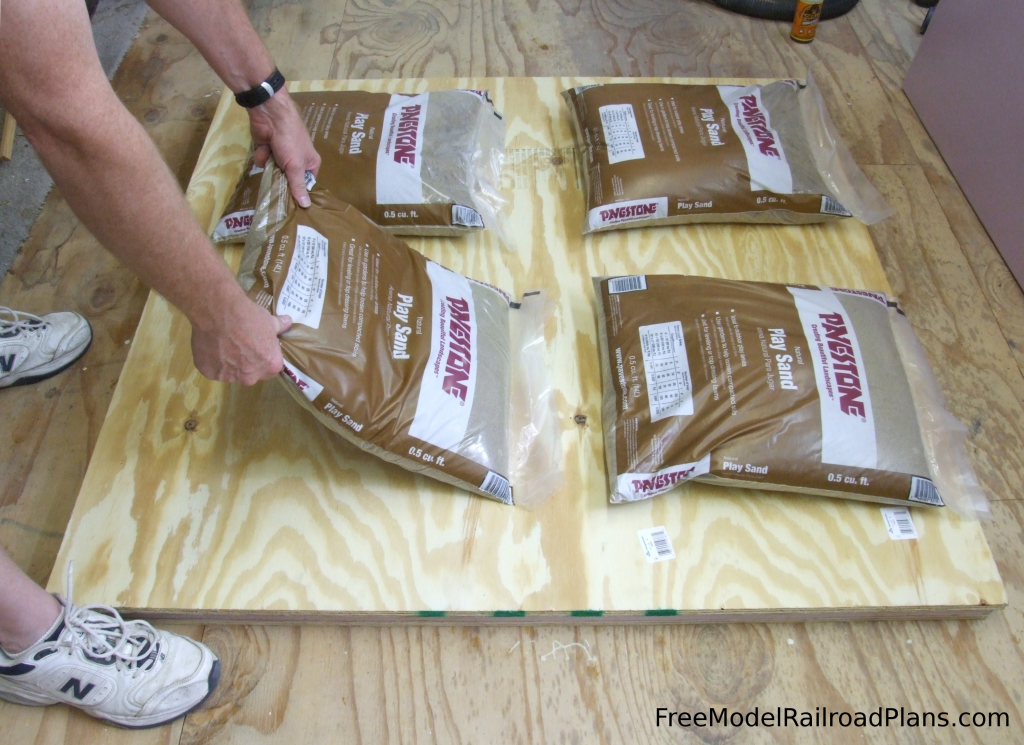
On our Roadbed: A Solid Foundation for your Model Railroad page of our O Gauge Model Railroad Layout Project, we show how to cut curved and straight pieces of roadbed from the finished 5mm plywood and foam sandwich to create an over-under figure 8 as shown in Figure 9. To learn how to calculate the grade and risers needed to create the figure 8, see our Calculating Model Railroad Grades page.
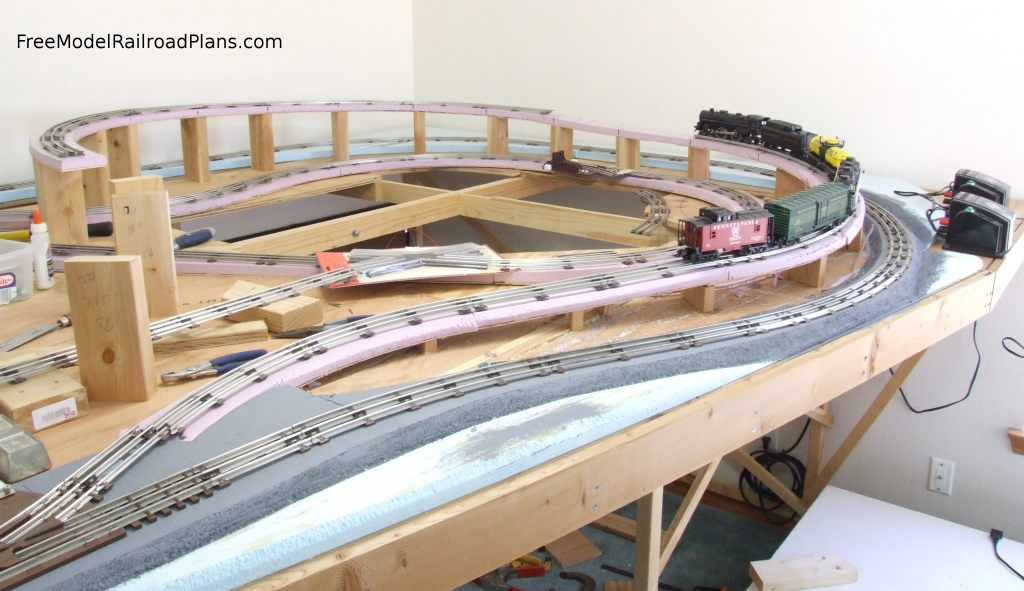
Go to:
Page 1: Deciding on a Location for your Model Railroad Layout
Page 2: Deciding How Much Space to Give Your Model Railroad Layout
Page 3: Building Benchwork for Your Model Railroad Layout
Page 4: Designing trackwork for your model railroad layout
Page 5: Building Roadbed for your model railroad layout
Please Support FreeModelRailroadPlans.com
FreeModelRailroadPlans.com is entirely user supported. If you find something of value here, please “pay it forward” and help us keep the site operating by a secure donation through PayPal (PayPal account is not required), or by shopping with our advertisers.
Thank you for your support!